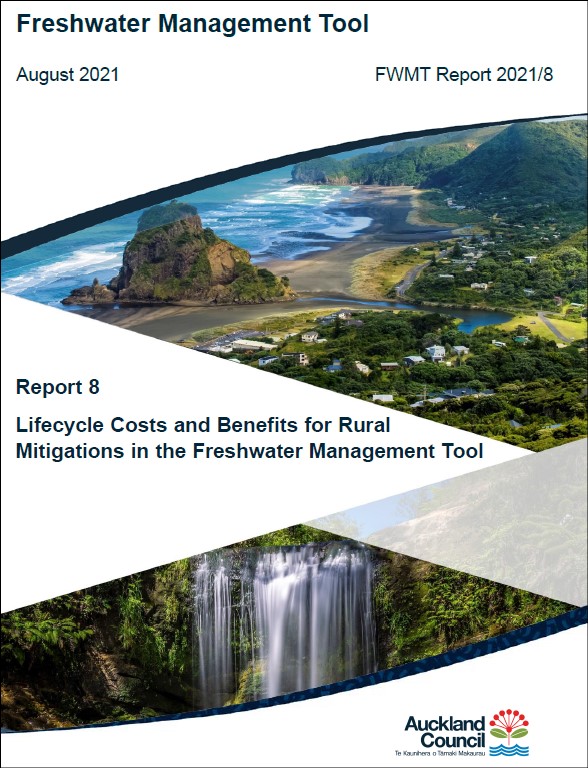Freshwater management tool: report 8. Lifecycle costs and benefits for rural mitigations
Author:
Auckland Council Healthy Waters Department, Tom Stephens, Perrin Ag Consultants, Carla Muller Koru Environmental Consultants, Sue IraSource:
Auckland Council Healthy Waters DepartmentPublication date:
2021Topics:
EnvironmentFreshwater management tool: report 8. Lifecycle costs and benefits for rural mitigations in the freshwater management tool
Executive summary
Auckland Council (AC) has requested that as part of their ongoing development of the Fresh Water Management Tool (FWMT), a staged approach is pursued to support rural costs and benefits of mitigations being assigned logical conditions for cost-optimisation. In the first step, rural literature was reviewed by Muller et al. (2020) and Muller and Stephens (2020) with the aim to provide initial estimates of mitigation options, cost and effectiveness.
This report takes cost and benefit information from Muller et al. (2020) and Muller and Stephens (2020) and translates it into a suitable format for the FWMT Stage 1. Recommendations extend to the applicability of mitigations across a hydrological response unit (HRU) framework, the land typology utilized by the FWMT. Baseline (2013-2017) and potential maximum levels of rural mitigation adoption are also considered to inform FWMT Stage 1 scenario modelling for water quality management.
The FWMT Stage 1 continuously simulates the baseline or current state of water quality (2013-2017) via process-modelling across the entire Auckland region, and enables optimization modelling across intervention types, to identify potential future states and associated management strategies (e.g., choice of intervention, targeted HRU type and sub-catchment, prioritised for cost over a 50-year discounted life-cycle). The FWMT Stage 1 enables both current and future states to be simulated for nutrients (nitrogen, phosphorus), heavy metals (copper, zinc), sediment and faecal indicator bacteria (E. coli). The FWMT thereby supports Auckland Council decision-making and management of water quality for existing, future development and climate associated pressures.
This report translates literature on rural water quality mitigation into a 50-year Life Cycle Cost (LCC). The LCC approach is consistent with urban water quality intervention recommendations produced in Ira, Walsh and Batstone (2020). This ensures the FWMT Stage 1 offers an integrated platform for water quality decision-making across the entire Auckland region. LCC estimates are based on capital, maintenance, replacement and where suitable, opportunity cost or reduced profit, throughout a 50-year period. LCC are supplied in Appendix 1 for discount rates of 2%, 4% and 6%.
The literature has been reviewed for bundled practice and system changes and land retirement, as well as edge-of-field (EOF) interventions, for reduced contaminant loss from pastoral and horticultural farming, including: wetlands (small, large), riparian management (fence only, grassed or planted setback only, fenced and grassed or planted setback), detainment bunds and space-planted erosion-control trees. For each, recommending reasonably assured cost and benefit for reduced total nitrogen (TN), total phosphorus (TP), total suspended sediment (TSS) and/or E. coli loss. Also, for each, ensuring applicability to the 50 HRU types spanning variation in pastoral and horticultural contaminant responses to climate within the FWMT (e.g., stratified over soil group, slope class, cover and use).
The rural mitigation literature was found frequently lacking key detail about components of cost, benefit, opportunity and/or baseline adoption rate, to enable application to individual HRU types. Instead, recommendations generally distinguish pastoral and horticultural HRU groups (e.g., by stock or crop, e.g. vegetable or tree, type). For instance, land retirement LCC estimates vary between dairying, intensive beef or sheep and beef farms for markedly varying likely opportunity cost.
This report is not an isolated piece of work, but a part of the broader FWMT development process and as such should be read in conjunction with the other ongoing technical work being undertaken by AC, underpinning a decadal model development programme. The FWMT Stage 1 is the first iteration which despite the complexity of a continuous and process-based approach, spanning 5,465 sub-catchments, 107 HRUs and multiple contaminants, is being developed from a principle of “defensible simplicity”. The granularity, cost and benefit estimates assigned to rural mitigations reflect that principle, ensuring only as fine a recommendation as defensible from the literature (e.g., to HRU group).
To aid ongoing FWMT development, the report identifies areas of rural water quality knowledge to prioritise for improved scenario modelling and freshwater accounting. Recommendations can be implemented through input from the rural sector, expert caucusing, field trials, and farm system modelling. Adoption of recommendations will improve the FWMT by improving LCC and benefit estimates, if not also increasing granularity thereof.
This report is structured as follows; Section 1 provides background information of the FWMT program. Section 2 provides a brief overview of key modelling components, including the Life Cycle Cost Model and FWMT. Section 3 provides details on how each mitigation was included into the Life Cycle Cost Model and FWMT. Section 4 covers the applicability of each mitigation to the HRU framework and what information could be used to inform baseline and potential adoption rates. Section 5 provides summary points and further recommendations. Finally, Appendix A provides key outputs from the Life Cycle Cost Model.
FWMT report 2021/8
Auckland Council, September 2022
*****
List of Freshwater Management Tool reports
2. Baseline configuration and performance | Report 2, appendices (in preparation)
3. Baseline state assessment (rivers) | Report 3, appendices (in preparation)
4. Current state assessment (lakes). Not published. Inquiries to: fwmt@aucklandcouncil.govt.nz
5. Review of the freshwater management tool. Baseline state assessment (rivers)
6. Literature review of primary sector responses to water quality: efficacy and cost
7. Riparian area management scenarios. Freshwater management tool
8. Lifecycle costs and benefits for rural mitigations in the freshwater management tool
11. Recommendations for improving rural mitigation modelling in the freshwater management tool
*****
Inquiries to: fwmt@aucklandcouncil.govt.nz
